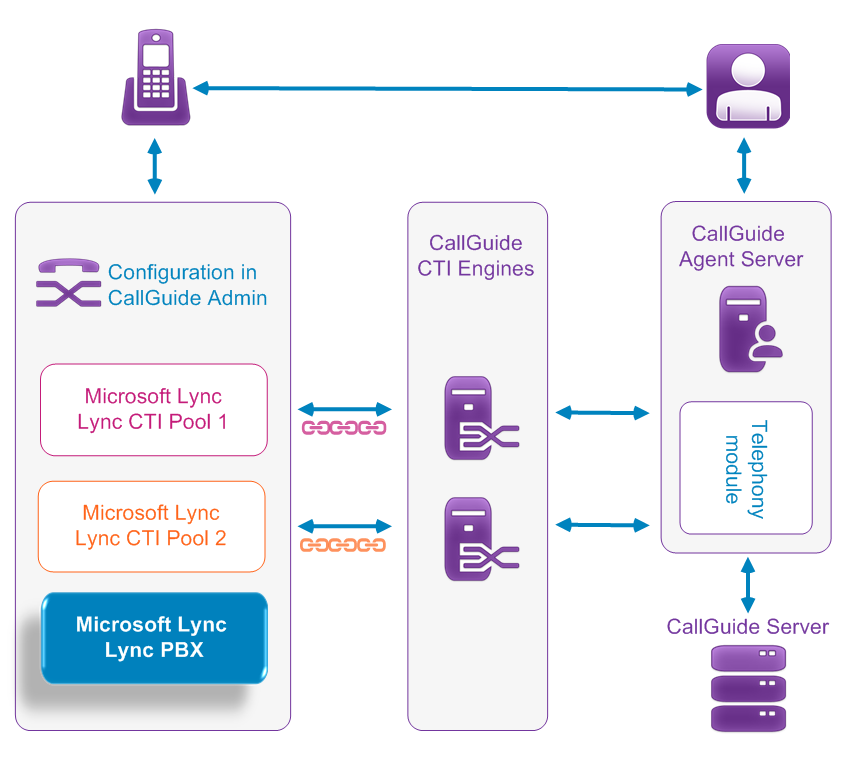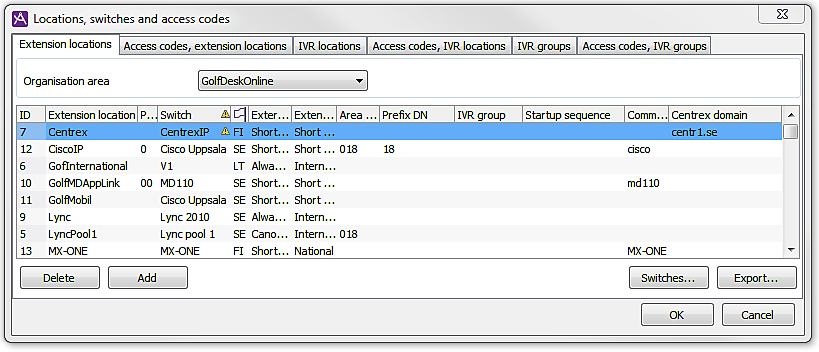
Microsoft Lync works in a somewhat different way than other traditional PBXs and must be handled accordingly.
For example, you can only have one Lync PBX connected to your ACE solution, but you still have to configure several virtual PBXs and two types of extensions.
In the following sections a couple of details are described, that you should be aware of if you are using Microsoft Lync as PBX.
For server based CTI the agent’s telephony connection is controlled by the telephony module in ACE Agent Server, via a CTI engine that in turn controls the agent’s extension under the PBX. See the picture above. As Microsoft Lync has no support for so-called 3PCC, third party call control, the agent’s telephone cannot be directed in the same way as for other PBXs. Extension numbers are normally associated to a telephone or a location where as in Microsoft Lync each user has his own number. So, in a CTI solution two different numbers are configured per extension; one extension number in Lync, connected to a corresponding virtual extension number in the CTI system. The number in Lync is here called PBX extension and the corresponding number to be used for communication in Telia ACE is called CTI extension.
When an agent logs in with his PBX extension he is assigned a CTI extension as well, from a number pool, described in the next section. Once logged in, just the CTI extension is used. The PBX extension number is seen in the main window for ACE Agent but the CTI extension number is the one that will always be presented as ANIS and DNIS, in contact data, in Interaction View etc.
The only exception is if the agents are using extension numbers to make internal calls, meaning that they are not using the recommended enquiry feature within ACE. In the following example Anna calls Bert:
If two servers contain the same data one can take over in case the other one crashes. As a Lync related CTI extension cannot exist in more than one ACE CTI Engine Server redundancy cannot be achieved in the same way as for other PBXs. In Telia ACE this is taken care of by dynamic CTI extensions in a pool, meaning that when the agent has logged in using his PBX extension, he is assigned a CTI extension from a pool of numbers, which can be distributed over several servers. To be able to handle pools with extension numbers you also require two different types of virtual PBXs; the main Lync PBX, handling PBX extension and a CTI PBX, named Lync CTI Pool here, for each pool with CTI extension numbers.
In the Switches for server based CTI you enter a name for your Lync-PBX as well as the names of the Lync CTI Pool PBXs that will contain the CTI extensions. Then you create the links that connects each Lync CTI Pool to his own CTI engine.
After having named and thus having created the PBXs as described above, you can create extension locations. In the Locations, switches and access codes, the Extension locations tab, the Extension location column, you name a main location, connecting it to your Lync-PBX that you can now pick from the drop-down menu in the PBXs column. Then, in the same way, specify the new locations to be connected to each respective Lync CTI Pool PBX.

The location for the main Lync PBX will not be handling telephony as such, why all settings for format, area code number etc are made at the extension location you have connected to a Lync CTI Pool. What else you have to specify is seen in the Locations, switches and access codes window, the Extension locations tab.